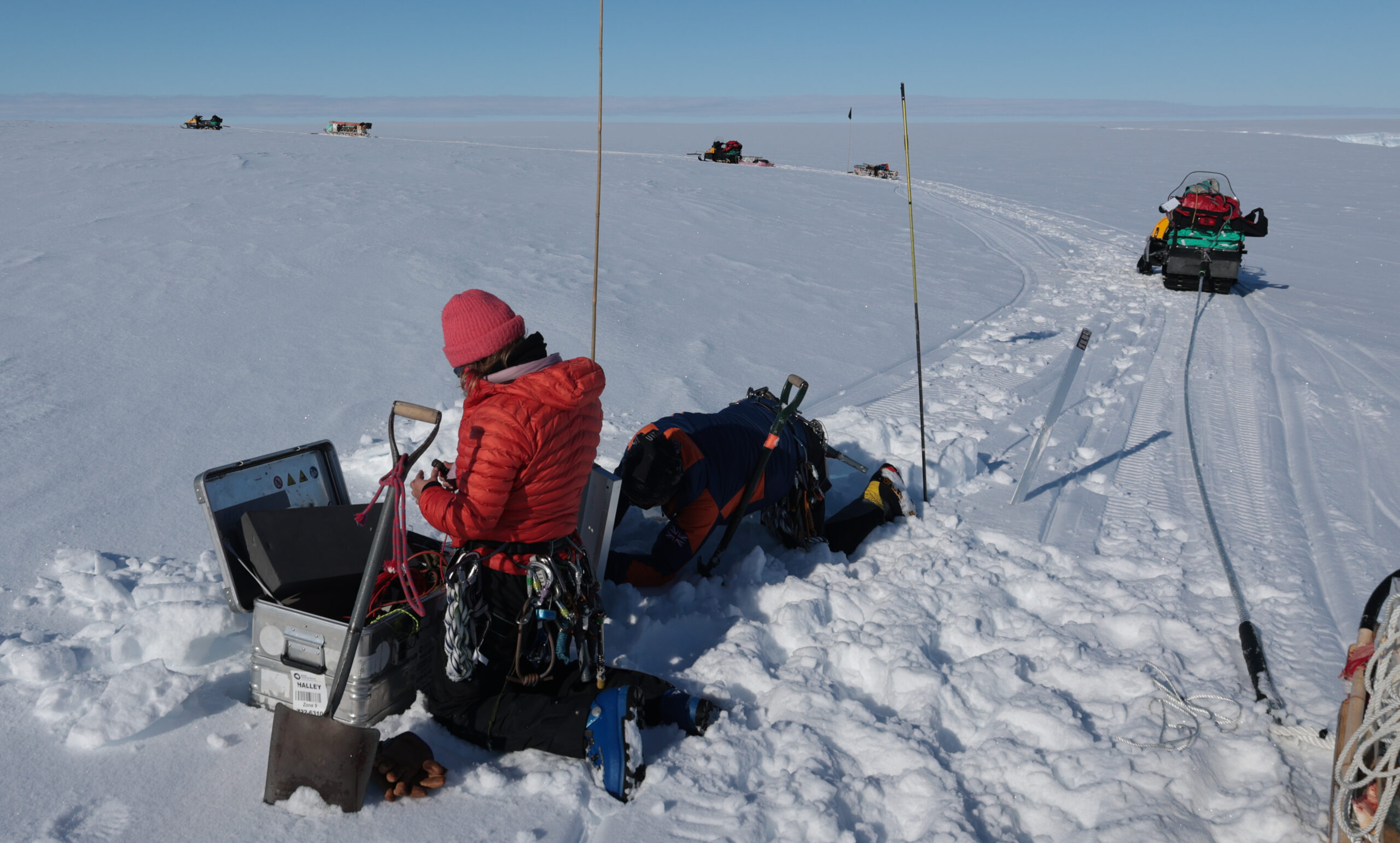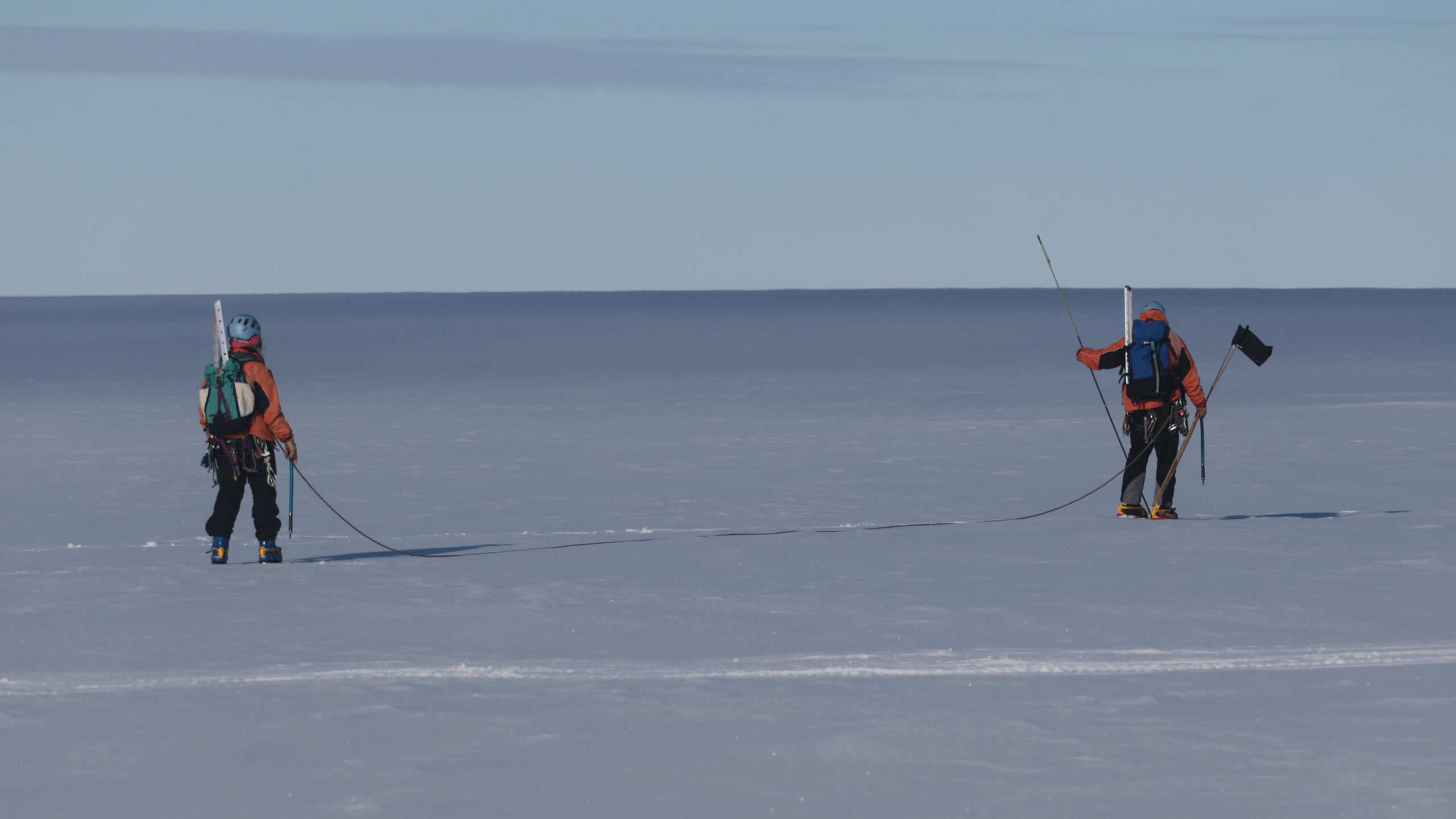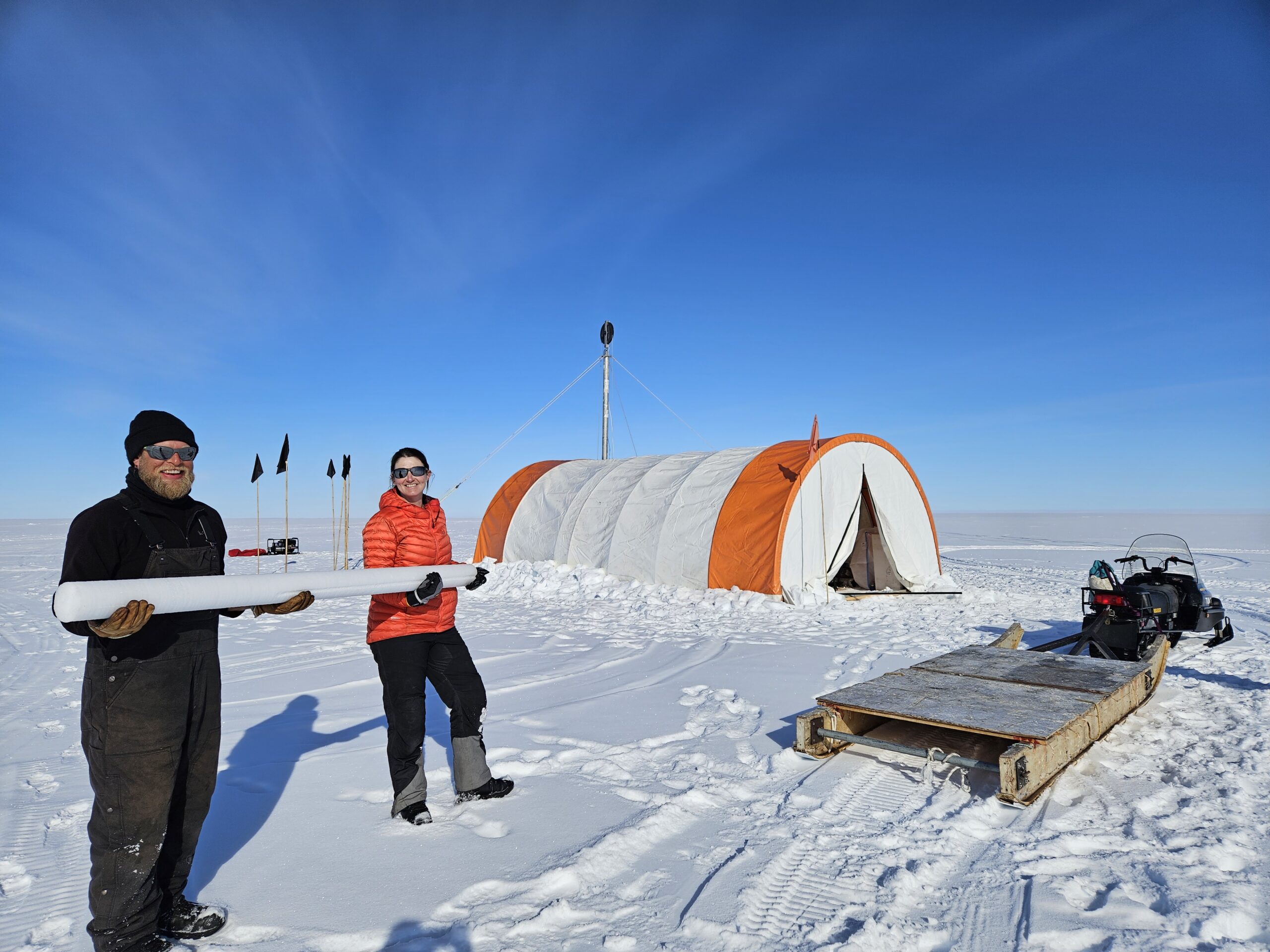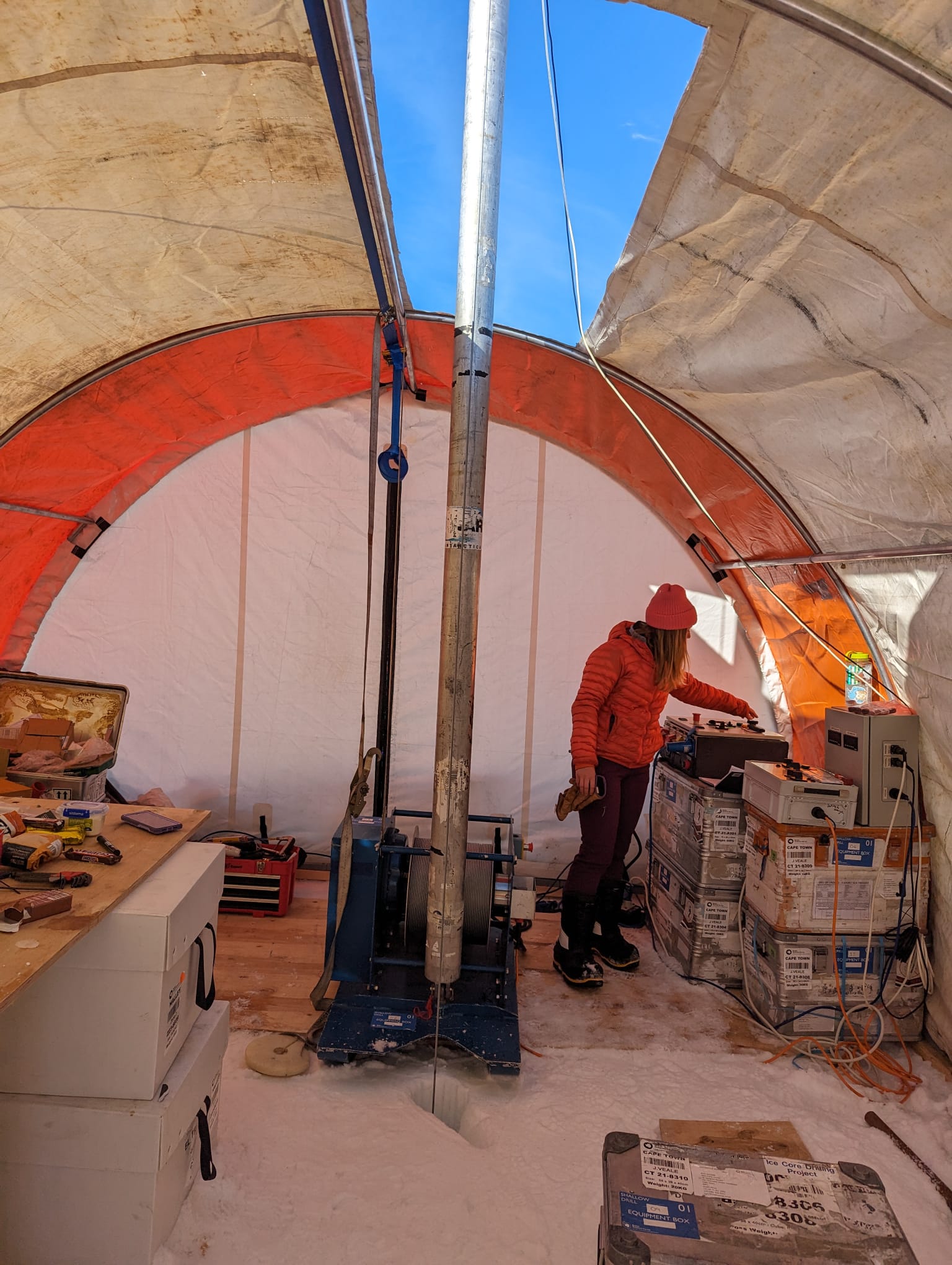Scientists one step closer to predicting iceberg calving
Scientists are a step closer to being able to predict when large icebergs will calve in Antarctica.
A team of glaciologists will present their new results at the European Geoscience Union Conference in Vienna this week (16 April 2024), having just returned from working on the Brunt Ice Shelf in Antarctica. The team spent 11 weeks collecting ice cores and geophysical data from the Brunt, in an effort to unravel the processes that take place as colossal icebergs are created from the ice.
The floating Brunt Ice Shelf is home to British Antarctic Survey’s (BAS) Halley VI Research Station and is one of the most studied ice shelves in the world. Scientists have been monitoring the movements of the ice shelf for over 50 years, and currently also use a network of 16 GPS instruments which collect and report data every hour.

Two massive icebergs have calved from the Brunt in recent years – A74 in 2021 and A81 in 2023 – but the physics behind ice fracturing is not well understood, making predicting major calving events difficult. Now, researchers are attempting to collect data which will paint a picture of the factors that influence the timing of crack growth and calving.
As well as having a wealth of historical data, the Brunt also has active rifts that are relatively accessible. This makes it an ideal test bed to study the processes that take place before a major calving. The team of researchers used seismic instruments, radar and GPS receivers to gather information about the evolution of the cracks on the ice shelf. These data provide information about the internal structure of the ice shelf which can’t be seen from satellite data, giving an insight into how the ice has been deformed and how the rift interacts with different types of ice.

Dr Emma Pearce, an ice fracture geophysicist at BAS, was part of the research team that headed to the Brunt. She will present results at EGU and says:
“This is an exciting step forward in understanding what happens to the ice before a giant iceberg calves off the ice shelf. In a similar way to an earthquake, when an ice shelf needs to release stress, you get an ice quake which can indicate rifts and fractures opening up. By collecting seismic data, we can get a better idea of where in the ice sheet these movements are happening and the magnitude of the response. From this season’s data, we can already see different types of seismic events showing us the fracture mechanisms of ice shelves aren’t just one simple process.”
They also drilled two ice cores. These shallow cores, measuring to a depth of 110 m, will be analysed to reveal the physical properties of the ice, including grain size, impurity content and toughness. The laboratory measurements will be combined with field observations to produce a three-dimensional mapping of the ice shelf which can be correlated with the location of seismic activity.
Dr Liz Thomas, head of the ice cores team at BAS, says:
“Ice cores can tell us a huge amount about the history of our atmosphere, but we’re using these cores to learn about something totally different. By understanding more about the physical properties of the ice around these rifts, we can better predict how rifts might form and behave in the future.”
“The Brunt Ice Shelf is made up of a mixture of continental ice and sea ice, both topped with layers of compacted snow. On the Brunt, fractures and rifts move through the sea ice, and slow down in the blocks of continental ice. This is the complete opposite to some other ice shelves, like Larsen C on the eastern side of the Antarctic Peninsula. Understanding why these ice shelves are behaving in such different ways is critical to our understanding of major calving events.”

Over the coming months, the ice cores and seismic data will be analysed. The team will return to the Brunt Ice Shelf next year, this time to the very end of a place called the Halloween Crack, 20 kilometres from the edge of the ice shelf. They’ll drill three boreholes into the continental ice, and a fourth one at the tip of the crack. As well as collecting ice cores, the team will lower fibreoptic cables through each borehole to collect high-resolution data on the seismic activity happening deep below the surface.
The results of this research will provide new insights into the fracture mechanism and help improve modelling predictions of major calving events.
Dr Oliver Marsh, a glaciologist at BAS and lead scientist of the project says:
“We had a very successful first season, and I’m excited to start analysing the results. We have been developing a physics-based model of the fracture process and we require these observations to constrain the model parameters and produce accurate predictions. Massive icebergs like A74 or A81 have implications both for the ice shelves they calve from and for the oceans and ecosystem along their drift paths. Understanding the timing of these events is critical to the long-term monitoring of the Antarctic environment.”

Calving of icebergs from the ice sheet into the Southern Ocean is one of the main ways that ice is lost from the Antarctic ice sheet. Increasing rates of calving could destabilise ice shelves and increase the contribution to sea level rise, with implications for coastal communities around the world.
Giant icebergs also have a significant impact on their local environment, modifying ocean circulation and affecting ice dynamics by allowing more ice to flow into the ocean. As icebergs drift into shallower water, wildlife can also be impacted as foraging routes are blocked, or as the iceberg scrapes along the ocean floor. As icebergs melt, they release a huge amount of freshwater, making the surrounding ocean less salty. However, this melting also releases nutrients into the water which benefit the growth of microscopic plants called phytoplankton, which form the base of the Antarctic food chain. Large icebergs also pose a threat to ships, as they break up into smaller chunks of ice.
This research is part of the RIFT-TIP project, which aims to provide insights into the mechanics of iceberg calving and fracture growth in ice shelves and contribute to our understanding of the impacts of climate change on Antarctic and its implications for global sea-levels.
If you missed the EGU press conference on this story, you can watch it online here.